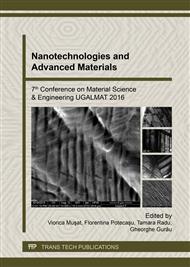p.145
p.154
p.160
p.167
p.174
p.180
p.188
p.194
p.200
Experimental and Statistical Analysis of the Nitrided Layer Behavior during a Wear Process
Abstract:
This paper aimed to develop a statistical analysis and studies the behavior of the thermo-chemically nitrided superficial steel layer characteristics during a dry wear process. The purpose of this study was to prove the causal relation between some characteristics of the superficial layer subjected to a wear process through the correlations between the depth of the worn-out superficial layer (Uh) or the mass loss (Δm) and the applied loading task (Q), during and after three hours of the wear process, taking into account two sliding degrees (ξ). After an experimental program, the obtained values were used to determine a correlation between these variables through an empirical study, to establish a causal relationship between them, using a statistical method. These characteristics were promoted according to behavior of the nitrided layer during the process of wear. To achieve this purpose we used a statistical method. The results of this study allow the prediction of the worn-out layer depth and the mass loss as a function of the normal load value.
Info:
Periodical:
Pages:
174-179
Citation:
Online since:
February 2017
Authors:
Price:
Сopyright:
© 2017 Trans Tech Publications Ltd. All Rights Reserved
Share:
Citation:


